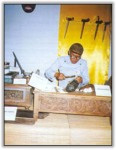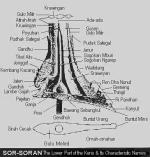Keris, the symbol of glory
A keris or kris is a special knife, a double-edged assymetrical stabbing weapon originating in Java which is used in a close range combat. It has spread its influence far beyond its initial beginnings to Bali, Lombok, Kalimantan, and even to Brunei Darussalam, Malaysia and Mindanao. From a stabbing weapon it has developed into a social status symbol and a symbol of manhood. According to Javanese keris lore, the development of keris can be assumed to take a parallel course with the kingdoms of Java. Unfortunately myth and fact are also intertwined that it is sometimes difficult to separate the two.
Some keris has been constructed entirely for magic and spiritual purpose. The creation is a long and complicated magical ritual which involves the blending of the metal with magical ingredients and the invoking of a powerful jinn/khodam spirit into keris. After keris has been created, the spirit is continually fed, so it gradually grows more powerful. They are often passed down from generation to generation. Our keris go back as far as the 8th century, when the most powerful magical knives and swords were made. They have become extremely potent through magical and spiritual usage and continuous feeding.
What gives keris its power is the genie (also known as Khodam or Jinn) that resides in it. The genie, or jinn, is a magical spirit that normally exists in a parallel dimension. The different powers will also reflect in the different ways of using them. Some are more suitable for experienced magicians, and like to be held in rituals, in which case they will add great power to the ritual. Some keris are easier to use by the beginner. You only have to hold it and visualize your desire and the jinn will work on fulfilling that desire. Others were created as family protectors, and can be used with no magical knowledge at all. All you have to do is hang it on the wall and feed it once a month and it will work quietly in the background, protecting you from harm, or drawing in wealth and good luck. There are some that can be carried on the person to confer authority on the carrier, silencing opponents and making you successful in all debates and interviews.
A keris can be used as a magical and spiritual aid in reaching and manifesting one’s desired goals and aspirations. The spirit which dwells within keris supports your daily aspects in terms of luck, wealth and health and interactions with people. The empus have created these magical blades with the thought that they will empower one’s aura and assist in one’s quest for desired qualities and enhancements in life. These are all infused into the item during its creation and these can all work to successfully aid one’s spiritual development.
Keris as the symbol of the glory of a historical era can be seen by its shape and its art. The older keris, the simpler the shape, the ornaments, and the function would be. The early function of keris is as a weapon to defend oneself, to preserve one’s life, and to function as a close range weapon. Preceding the development of culture and art, the shape of Keris changed according to the need and it’s contribution to human’s life, among others it could indicate the social status of the owner of keris. Keris also functions as the symbol of power (Wahyu Keraton).
Keris has two kinds of shape: straight keris and meandering keris. There are approximately 200 kinds of straight Keris and 250 kinds of meandering keris. The meander is called luk. Meandering Keris always has odd numbers of meander, from luk 3 up to luk 29, above luk 29 that is luk 31 up to luk 51 are the kriya artwork from outer Java.











“Elle est belle, elle est tres feminin.” “She is beautiful. She is so feminine.”
I recall the words of my friend Nadia when I first showed a keris to her, as we sat on the verandah of my friend’s wooden house in the village of Bacok, Kelantan.
The keris, she remarked, was a beautiful object: Graceful, elegant and curiously feminine. Yet I was not surprised. This was not the first time I heard the keris described as a feminine object; indeed many of my European friends had uttered similar remarks. Their observations were not unwarranted: Even to the seasoned eye of the keris lover, the keris is an object of beauty – and its discreet, unstated charm lay precisely in the fact that it was slender, willowy, almost vulnerable and rendered all the more dignified with the patina of time-worn antiquity.
Yet how odd it is, that today, this most overdetermined symbolic fetish of the peoples of Nusantara has developed an alter-ego totally unkeeping with its past and purpose. What was once an object of adoration and reverence has now become nothing less than a symbol of ethno-nationalist exclusivism, a totem of aggressive masculinity, and an emblem of a racialised communitarianism. Pity the poor keris: An object so noble deserves a better fate than to be sullied by such ignoble purposes…
The feminine Keris: Not a macho symbol.
It is in keeping with many right-wing movements that their members and leaders would be on the lookout for some symbol of power. That the keris could be politically and ideologically redefined as a symbol of racialised masculine pride is not uncommon nor unexpected. Just take a look around us and we will notice that practically all right-wing organisations have adopted some weapon or another to stand for the purported claims of male leaders who wish to make their political will and intent public through some phallic fetish or another. Right-wing movements (particularly of the militarist variety) have chosen all kinds of weapons to stand in the place of masculine power: Guns (notably Kalashnikovs), rockets, missiles, swords, axes, hammers, spears, arrows, darts and even knuckle-dusters have festooned the shields and banners of so many right-wing nationalist movements that it would take years to catalogue them all.
The use of the keris as a symbol of male power is thus easily understood, though it begins with the fundamental error of thinking of the keris as solely and primarily a weapon. We have argued elsewhere that the keris was first and foremost an object of religious devotion and a symbol of religio-cultural identity.
Its origins date back to the Hindu-Buddhist era of Southeast Asia when the peoples of the region had other weapons to chose from. Indeed, there exists little historical evidence that the keris was ever used in warfare.(2) The peoples of Nusantara had other weapons to chose from when it came to butchering each other, from swords and axes to machetes and spears. Later on by the late 18th century with the arrival of new weapons technology from India, the Arabs and Europeans, Southeast Asians adopted the use of muskets and then guns and cannons.
The keris was primarily a ceremonial object and its production was initially kept to select elite of Brahmin-craftsmen whose knowledge of metalwork and keris-making were closely guarded secrets. It was never meant to be a popular item for the masses, but rather a religio-cultural totem of identity and belief; which is why there were so many esoteric rites and rituals that guarded the sacred world of this fetish.
One of the esoteric aspects of keris-lore was its intimate link to the philosophy and praxis of Tantrism, an ancient pre-vedantic system of beliefs and cosmology that pre-dated the vedantic-Aryan teachings that would later develop and be known as Hinduism. Tantraism is today regarded as one of the earliest world religions and philosophies, and for feminists in particular is particularly highly regarded for its view of Woman as the centre of creation. It would not be possible to delve too deeply into the Tantric influences on the keris in an article like this, suffice to say that the tantric aspects of the keris and keris-lore can be seen in the symbolism contained in it.
The keris, it has to be remembered, is a composite object: It consists of the blade (mata keris) as well as the sheath (sarong keris); and in the symbolic coupling of the two (the keris inserted into the sheath or sarong) we see the symbolic enactment of the sexual act of copulation or intercourse. Here the upright keris assumes its phallic identity as the penetrating element (linggam), while the sheath assumes the status of penetrated object (yoni). But a tantric reading of this would reverse the order of interpretation by arguing that the masculine power of the keris blade is being enveloped and thus contained within the sacred feminine space of the sheath; thereby bringing about equilibrium and order, when the feminine encapsulates, embodies and contains the masculine.
Ultimately, therefore, harmony in the universe is achieved when the expansive (and potentially destructive) power of the masculine is domesticated and tamed by the feminine. (Dedicated lovers of femdom would understand what I mean by this, but let me not digress…)
The composite keris (that is, the blade and the sheath assembled together) is thus a feminine object in the way that the feminine aspect is evident while the masculine is hidden. This is how the keris is traditionally meant to be seen and presented: Always in its sheath and never unsheathed in public. Once, while interviewing a wizened old keris lover in Java, I was told that “the true lover of the keris will always keep his keris in the sheath. He never leaves it unsheathed, or displays the blade in public”. Why, I asked the Obi-Wan of kerisdom.
“Because only an uncultured brute (orang yang kasar) would do that. Would you ask your daughter to walk around naked in public, for all to see? If you love your keris, you would dress it up, keep it covered. That is why the sheath is called the sarong keris. Like a sarong, it has to be worn, to keep the keris decent, to respect its dignity. Itu baru yang sopan Mas Farish, hanya goblok kasar yang telanjangkan kerisnya…”
For cultured Southeast Asians in the past such as the Javanese, the art of wearing the keris was as important as the keris itself.
To unsheath the keris was an affront to society, the keris and the keris-owner. It was an expression of crude, brutish masculinity that bordered on the uncivilised and bestial. Yet tell that today to those demagogues who brandish the keris in public as soon as a camera is pointed at them. By taking the keris out of the sheath and separating it from its feminine counterpart, the sarong, they have rendered the feminine secondary. Here lies the symbolic machismo of the act, and in this singular gesture a feminine object of reverence and beauty has been transformed into a masculine symbol of power, aggression and violence.
Let us bring back integrity. Let us respect the wholeness of the mata keris and the sarong keris.
Dengan hormat, Farish A. Noor